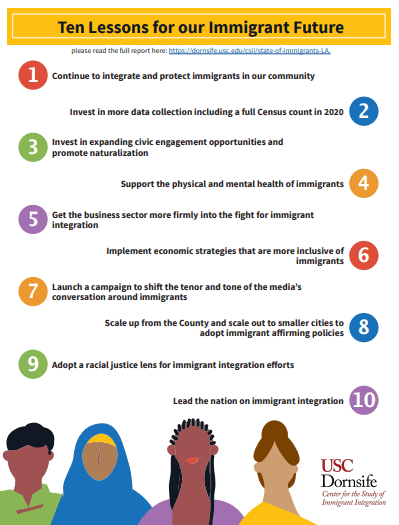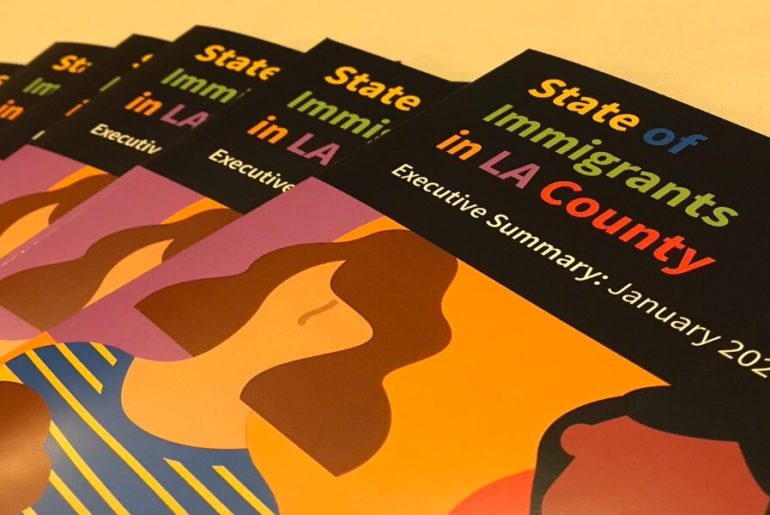LOS ANGELES – Over 300 leaders from the immigrant rights movement, nonprofits, academia, local and state government, and philanthropy attended the 1st Annual Immigration Integration Summit last Thursday, January 8, 2020. This first of its kind immigration summit was held in conjunction with the release of the first annual State of Immigrants in Los Angeles (SOILA) report. Published by The Center for the Study of Immigrant Integration and the Council on Immigrant Integration, the report provides a well-informed baseline for understanding how immigrants in LA County are contributing and thriving economically and civically, as well as an analysis on how well the LA County and organizations within the county has done in welcoming them.
Los Angeles has had a long and complex history welcoming immigrants. Within this Executive Summary, we find overviews and analysis of both the anti-immigrant and pro-immigrant policies the county has passed in the last fifty years. The summary notes, “L.A. County has shifted from creating a system of attrition for immigrants to embracing them as a community.” In her opening remarks for the summit, California Community Foundation’s President and CEO, Antonia Hernández, marks this transition, “We have been reactive…it is time for us to embrace our immigrant roots and embrace a more strategic, proactive agenda to integrate immigrants. A person who enters LA County is a citizen in the making.”
It is in this context that the report explores how L.A.’s immigrant communities are faring across three key areas of integration: economic mobility, civic engagement, and warmth of welcome. Dr. Manuel Pastor of USC’s CSII presented the report findings, explaining that the research team chose these three indicators because they assess if “immigrants are integrated well into their receiving community—something that is equally the responsibility of immigrants and the receiving community.” For example, the capacity for a community to provide English as a Second Language (ESL) classes and other social support services is a potential indicator of the openness of a receiving society. This report states that L.A. County is behind Alameda County in the services it provides with three immigrant-serving organizations per 100,000 non-citizens to Alameda’s ten. In this example, L.A. County, the county with one of the largest population of immigrants, is less robust than others in the surrounding area.
Please read the full report here: https://dornsife.usc.edu/assets/sites/731/docs/SOILA_full_report_v19.pdf.
Revolution English shares excerpts from the report’s Executive Summary below:
Immigrants are part of the fabric of LA County:
- Immigrants have been in Los Angeles for a long time: 67 percent of lawful permanent residents (LPRs) have been in the United States for longer than 10 years and a similar amount (68 percent) of undocumented residents have also been in the U.S. for longer than 10 years.
- Overall, nearly 20 percent of residents in Los Angeles County are either undocumented themselves or live with a family member who is undocumented.
Immigrants are an untapped civic force:
- 768,000 immigrants in Los Angeles County were eligible to naturalize in 2016 but had not yet done so.
- One clear barrier to engagement experienced by the immigrant population is, of course, language. About 30 percent of all immigrant-headed households are linguistically isolated, defined as having no member age 14 or older who speaks English at least ‘very well’.
Immigrants are the bedrock of the Los Angeles economy:
- Despite the large presence of immigrants in the workforce, they still suffer from economic inequalities. Immigrants have a generally high employment rate, but nonetheless are still in poverty. One in five foreign-born workers, and more than one in three undocumented workers experience working poverty (working full time with family income below 200 percent of the federal poverty level).
- Immigrant households make up about 30 percent of total household income in Los Angeles County and comprise a significant portion of our consumer base in Los Angeles.
There is better, more robust infrastructure for welcoming immigrants, however these structures may not be in place everywhere.
- Adult ESL enrollment has increased since 2014-2015, hitting a peak of around 86,000 during the 2016-2017 academic year.
- In terms of social supports, Los Angeles has one of the largest immigrant populations across California; however, coverage in terms of immigrant serving organizations is less robust when compared to other counties.
The report concludes with recommendations for LA County institutions, organizations, elected leaders and constituents to consider in the movement toward immigrant integration and inclusion:


